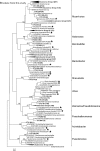Hydrocarbon-degrading bacteria and the bacterial community response in gulf of Mexico beach sands impacted by the deepwater horizon oil spill
- PMID: 21948834
- PMCID: PMC3208977
- DOI: 10.1128/AEM.05402-11
Hydrocarbon-degrading bacteria and the bacterial community response in gulf of Mexico beach sands impacted by the deepwater horizon oil spill
Abstract
A significant portion of oil from the recent Deepwater Horizon (DH) oil spill in the Gulf of Mexico was transported to the shoreline, where it may have severe ecological and economic consequences. The objectives of this study were (i) to identify and characterize predominant oil-degrading taxa that may be used as model hydrocarbon degraders or as microbial indicators of contamination and (ii) to characterize the in situ response of indigenous bacterial communities to oil contamination in beach ecosystems. This study was conducted at municipal Pensacola Beach, FL, where chemical analysis revealed weathered oil petroleum hydrocarbon (C₈ to C₄₀) concentrations ranging from 3.1 to 4,500 mg kg⁻¹ in beach sands. A total of 24 bacterial strains from 14 genera were isolated from oiled beach sands and confirmed as oil-degrading microorganisms. Isolated bacterial strains were primarily Gammaproteobacteria, including representatives of genera with known oil degraders (Alcanivorax, Marinobacter, Pseudomonas, and Acinetobacter). Sequence libraries generated from oiled sands revealed phylotypes that showed high sequence identity (up to 99%) to rRNA gene sequences from the oil-degrading bacterial isolates. The abundance of bacterial SSU rRNA gene sequences was ∼10-fold higher in oiled (0.44 × 10⁷ to 10.2 × 10⁷ copies g⁻¹) versus clean (0.024 × 10⁷ to 1.4 × 10⁷ copies g⁻¹) sand. Community analysis revealed a distinct response to oil contamination, and SSU rRNA gene abundance derived from the genus Alcanivorax showed the largest increase in relative abundance in contaminated samples. We conclude that oil contamination from the DH spill had a profound impact on the abundance and community composition of indigenous bacteria in Gulf beach sands, and our evidence points to members of the Gammaproteobacteria (Alcanivorax, Marinobacter) and Alphaproteobacteria (Rhodobacteraceae) as key players in oil degradation there.
Figures





References
-
- Acosta-Martinez V., Dowd S., Sun Y., Allen V. 2008. Tag-encoded pyrosequencing analysis of bacterial diversity in a single soil type as affected by management and land use. Soil Biol. Biochem. 40:2762–2770
-
- American Public Health Association 1969. Standard methods for the examination of water and wastewater, including bottom sediments and sludge. American Public Health Association, Washington, DC
-
- Atlas R. M. 1991. Microbial hydrocarbon degradation, bioremediation of oil spills. J. Chem. Technol. Biotechnol. 52:149–156
-
- Berthe-Corti L., Nachtkamp M. 2010. Bacterial communities in hydrocarbon-contaminated marine coastal environments, p. 2350–2357 In Timmis K. N. (ed.), Handbook of hydrocarbon and lipid microbiology. Springer-Verlag, Berlin, Germany
Publication types
MeSH terms
Substances
LinkOut - more resources
Full Text Sources
Other Literature Sources

